In pre-contact times, sugarcane was not processed as we know sugar today, but was used by chewing the juicy stalks. Its leaves were used for inside house thatching, or for outside (if pili grass wasn’t available.) The flower stalks of sugar cane were used to make a dart, sometimes used during the Makahiki games. (Canoe Crops)
The first written record of sugarcane in Hawaiʻi came from Captain James Cook, at the time he made initial contact with the Islands. On January 19, 1778, off Kauai, he notes, “We saw no wood, but what was up in the interior part of the island, except a few trees about the villages; near which, also, we could observe several plantations of plantains and sugar-canes.” (Cook)
Cook notes that sugar was cultivated, “The potatoe fields, and spots of sugar-canes, or plantains, in the higher grounds, are planted with the same regularity; and always in some determinate figure; generally as a square or oblong”. (Cook)
Sugarcane, a tall perennial grass, is grown in tropical and semitropical climates. (USDA)
To plant it, short sections of sugar cane plant stalk containing one or more node are first planted in soil which has been deep-plowed and formed into furrows that follow the contour of the land. In about 24 months a mass of vegetation (up to 10-feet high) has developed and is ready for harvest.
There are two factors that distinguish cane sugar production in Hawaii from cane sugar production in other parts of the world. First, growers do not harvest Hawaiian sugarcane until it is an average of two years old. In most other areas, sugarcane is harvested after one year of growth. (EPA)
Prior to World War II, almost all cane was cut by hand and transported to the sugar mills through an extensive network of water flumes. When water flumes did not exist, mule-drawn wagons carried the cane to rail roads for transport.
Following World War II, mechanical harvesting completely replaced the hand cutting of cane. The most common method of harvesting is to snap off the cane at ground level with a bulldozer-type push rake on a large standard tractor. (EPA)
Sugar cane is processed at two facilities: processing starts at a raw sugar factory and finished at a sugar refinery. The following address raw sugar processing. (Sugar Association)
When harvested, the root structure is left intact so that a second, third, or even fourth crop of sugar cane may be produced from suckers which grow from the root structure of old harvested plants. This process is known as ‘ratooning.’
Bulldozers then rake the cane into piles for cranes, equipped with special grabs, to load the cane into special cane haulers usually consisting of an enormous truck-tractor unit and semi-trailer. (EPA)
The operations necessary for making raw cane sugar are as follows :
- The extraction of the juice.
- The purification of the juice.
- The evaporation of the juice to syrup point.
- The concentration and crystallization of the syrup.
- The preparation of the crystals or grains for the market by separating them from the molasses. (Rolph)
The cane initially moves to a feeder table, up a conveyor, and then contacts a drum which spreads it out into a thin even blanket. Next it passes over a set of rollers which acts as a primary rock extractor. From there it falls into a flotation bath where rocks and other heavy foreign matter settle in the tank and are carried away. (EPA)
Following the flotation bath, the cane proceeds up a conveyor where heavy washing begins. Next it passes over drums to be shaken and leveled. The root structure holding the stalks together is then broken and here also final washing occurs.
The cane then moves over trash extractors (oppositely spinning rollers) which grab and strip leaves from the stalks. The resulting trash is conveyed away from the cleaning plant. A series of knives then cut the cane into small lengths for crushing by a pair of corrugated rollers.
Typically, the milling is through a tandem of three rollers, and the chopped cane passes through each mill in succession to remove the sugar cane juice. Either three, four, or five mills in a series are employed to squeeze the juice out of the cane stalks. (EPA)
Following extraction, sugar cane juice is sent through a clarifier; after leaving the clarifier, the juice enters a multi-effect steam evaporator from which it emerges with greater density as ‘syrup.’
The syrup then enters vacuum pans where it is converted into molasses. In the pans, sugar crystals are also formed from the syrup by the process of evaporation to saturation. At the end of this operating cycle, the crystals are centrifuged to remove the molasses.
The sugar from the first pan operation is of commercial raw sugar quality and is ready for shipment to a mainland refinery. The molasses remaining from centrifuge of the first boiling operation is called ’A’ molasses. This is returned directly to the pans for a second cycle.
The material from the second pan operation is centrifuged and the sugar produced is also of commercial quality. The molasses remaining from the second pan operation is called ‘B’ molasses. ‘B’ molasses is of low quality sugar content and must be specially processed before additional sugar can be produced. (EPA)
The raw sugar is then sent in bulk to refineries (C&H) for finishing, packaging and marketing/shipping. The initial step in cane sugar refining is washing the sugar, called affination, with warm, almost saturated syrup to loosen the molasses film.
There are a variety of steps of heating, separation of sugar crystals (in centrifuges), screening, washing and clarification. Two clarification methods are commonly used: pressure filtration and chemical treatment.
To produce refined granulated sugar, white sugar is transported by conveyors and bucket elevators to the sugar dryers. The most common sugar dryer is the granulator, which consists of two drums in series. One drum dries the sugar and the other cools the dried sugar crystals.
In addition to granulated sugar, other common refined sugar products include confectioners’ (powdered) sugar, brown sugar, liquid sugar, and edible molasses. (Food and Agricultural Industry; EPA) (The color and flavor of brown sugar come from the residual molasses left in the crystals during the refining process.)
Several waste products are produced by the sugar industry in raw sugar processing – one was bagasse, and the mills would flume it out of the mill and simply dump it in the ocean.
Later, some of the bagasse was made into canec. In 1929, Hawaiian Cellulose Ltd, a subsidiary of the Waiākea Mill Company applied for a patent for the manufacture of it. (County of Hawai‘i) They made ‘canec.’
Canec was originally the brand name for pressed fiber board made by Hawaiian Cane Products, Ltd., but it has become commonly used to refer to all pressed board of this type.
Also, later, “After passing through the last mill, as much cane pulp (bagasse) as needed is fed into the mill fireroom for use as fuel.” (EPA) The bagasse was pelletized and fueled the boiler.
In 1906, the California and Hawaiian Sugar Refining Company (C&H) began refining pure cane sugar in the small town of Crockett, California, near San Francisco. As cargo ships offloaded raw cane sugar from the Hawaiian Islands, the refinery employed 490 people and produced 67,000 tons of refined cane sugar.




















































